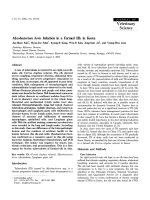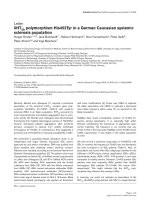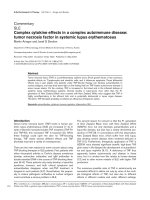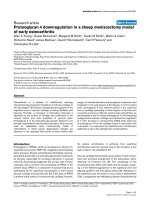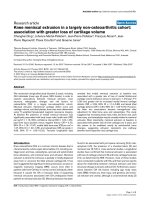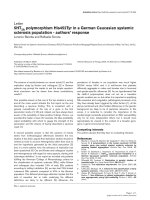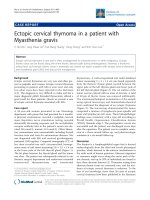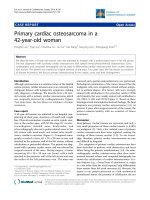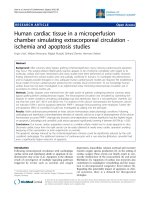Báo cáo y học: "Cutaneous Fusarium infection in a renal transplant recipient: a case report" pdf
Bạn đang xem bản rút gọn của tài liệu. Xem và tải ngay bản đầy đủ của tài liệu tại đây (2.06 MB, 3 trang )
CAS E REP O R T Open Access
Cutaneous Fusarium infection in a renal
transplant recipient: a case report
John S Banerji
*
and Chandra Singh J
Abstract
Introduction: Fungal infections in the immunocompromised host are fairly common. Of the mycoses, Fusarium
species are an emerging threat. Fusarium infections have been reported in solid organ transplants, with three
reports of the infection in patients who had received renal transplants. To the best of our knowledge, this is the
first case of an isolated cutaneous lesion as the only form of infection.
Case presentation: We report the case of a 45-year-old South Indian man who presented with localized
cutaneous Fusarium infection following a renal transplant.
Conclusion: In an immunocompromised patient, even an innocuous lesion needs to be addressed with the
initiation of prompt treatment.
Introduction
Fusarium species are common soil saprophytes and
plant pathogens. Young and Meyers [1] first reported
Fusarium infection in the l ate 1970s. Sinc e then, several
species have b een recognized to be agents of superficial
infections (keratitis, cutaneous infections, onychomyco-
sisandinfectionofwoundsorburns)inhumans[2].
More recently, deep-seated, disseminated infections have
been increasingly descri bed in immunocompromised
patients, especially in neutropenic patients [3,4]. The
prognosis is very poor, and death occurs in up to 70%
of the cases despite antifungal therapy [4]. The Fusar-
ium species most frequently involved in human infec-
tions are Fusarium solani, F. oxysporum and F.
moniliforme.
Case report
A 45-year-old South Indian man underwent a renal allo-
graft transplant for end-stage renal disease. He was admi-
nistered tacro limus, mycophenolate and prednisolone as
immunosuppressive therapy. On follow-up at six months,
he complained of a small, painless nodule o n his right
calf. He had no fever, redness or pruritus. He had no
other opportunistic infection. Clinical examination
revealed a subcutaneous, 2 × 2-cm, firm, violaceous
nodule with normal surrounding skin ( Figure 1). He had
no other similar lesions. There was no regional lympha-
denopathy. The rest of the physical examination was nor-
mal. His hemogr am was normal, as were his computed
tomographic chest and abdominal ultrasound scans. He
underwent fine-needle aspiration of the nodule, which
was reported to have inflammatory cells and a few fungal
hyphae. He subsequently underwent excision of the
nodule, which was sent for microbiological evaluation.
The finding was reported to be Fusarium solani.
A biopsy sample was cultured for fungi on Sabouraud
dextrose agar without cycloheximide and was incubated
at 25°C in air for four days. It grew whitish-gray cottony
colonies suggestive of Fusarium spp. Successive subcul-
tures performed on potato dextrose agar in the dark
stained with periodic acid-Schiff showed sickle-shaped,
multiseptated macroconidia, and one- to two-celled
microconidia had formed from unbranched phialides,
conidiophores and chlamydospores typical of Fusarium
solani (Figure 2).
Subsequently, species identification was further per-
formed using immunohistochemistry (Figure 3). The
patient was successfully treated with surgical excision of
the lesion followed by four weeks of oral voriconazole
treatment.
Discussion
Fusarium species are u biquitous and may be found in
the soil and air and on plants. In humans, Fusarium
* Correspondence:
Department of Urology, Unit 1, Christian Medical College, Vellore, India
Banerji and Singh J Journal of Medical Case Reports 2011, 5:205
/>JOURNAL OF MEDICAL
CASE REPORTS
© 2011 Banerji and Singh J; licensee BioMed Central Ltd. This is an Open Access article distributed under the terms of the Creative
Commons Attribution License ( which permits unrestricted use, distribution, a nd
reproduction in any medium, provided the original work is properly cited.
specie s cause disease that is localized, focally invasive or
disseminated. The pathogen generally affects immuno-
compromised individuals, with infection of immuno-
competent persons bei ng rarely reported. Localized
infection includes sept ic arthritis, endophthalmitis,
osteomyelitis, cystitis and brain abscess. In these situa-
tions, a relatively good response may be expected fol-
lowing appropriate surgery and oral antifungal therapy.
Disseminated infection occurs when two or more non-
contiguous sites are involved [5]. The skin can be an
important and early clue to diagnosis, since cutaneous
lesions may be observed at an early stage of the disease.
Typicalskinlesionsmaybepainful red or violaceous
nodules, the center of which often becomes ulcerated
and covered by a black eschar. The multiple necrotizing
lesions are often observed on the trunk and the extremi-
ties [6].
Our patient had a single, localized nodule that was
treated successfully with surgical excision and antifungal
therapy. He did not have any signs of disseminated
infection. At the last follow-up appo intment, he had no
symptoms of any disseminated fungemia. Amphotericin
has been the drug of choice to treat most fungal infec-
tions. The use of azoles, namely, voriconazole, posaco-
nazole and ravuconazole, has also been found to be
promising [7]. As the patient was a renal transplant reci-
pient, we chose to use voriconazole to treat him as it
has shown good response in most zygomycoses.
Conclusion
Opportunistic infections in transplant recipients can be
life-threateni ng. Fusarium infections are recognized
more often, and unless they are diagnosed and treated
early, they can be a cause of significant morbidity and
mortality.
Figure 1 Nodule on the patient’s right calf.
Figure 2 Periodic acid-Schiff stain-positive spores of Fusarium
solani.
Figure 3 Fusarium solani identified by immunohistochemical
staining.
Banerji and Singh J Journal of Medical Case Reports 2011, 5:205
/>Page 2 of 3
Consent
Written, informed consent was obtained from the
patient for publ ication of this case report and accompa-
nying images. A copy of the written consent is available
for review by the Editor-in-Chief of this journal.
Acknowledgements
We acknowledge the contribution of Dr. Sanjeev Shah from the Department
of Pathology.
Authors’ contributions
JSB analyzed and interpreted the patient’s data and was involved in writing
the manuscript. CSJ was involved in drafting the manuscript.
Competing interests
The author declares that they have no competing interests.
Received: 19 May 2010 Accepted: 25 May 2011 Published: 25 May 2011
References
1. Young CN, Meyers AM: Opportunistic fungal infection by Fusarium
oxysporum in a renal transplant patient. Sabouraudia 1979, 17:219-223.
2. Guarro J, Gené J: Opportunistic fusarial infections in humans. Eur J Clin
Microbiol Infect Dis 1995, 14:741-754, 1995.
3. Boutati EI, Anaissie EJ: Fusarium, a significant emerging pathogen in
patients with hematologic malignancy: ten years’ experience at a cancer
center and implications for management. Blood 1997, 90:999-1008.
4. Rabodonirina M, Piens MA, Monier MF, Guého E, Fière D, Mojon M:
Fusarium infections in immunocompromised patients: case reports and
literature review. Eur J Clin Microbiol Infect Dis 1994, 13:152-161.
5. Blazar BR, Hurd DD, Snover DC, Alexander JW, McGlave PB: Invasive
Fusarium infections in bone marrow transplant recipients. Am J Med
1984, 77:645-551.
6. Girardi M, Glusac EJ, Imaeda S: Subcutaneous Fusarium foot abscess in a
renal transplant patient. Cutis 1999, 63:267-270.
7. Walsh TJ, Groll AH: Emerging fungal pathogens: evolving challenges to
immunocompromised patients for the twenty-first century. Transpl Infect
Dis 1999, 1:247-261.
doi:10.1186/1752-1947-5-205
Cite this article as: Banerji and Singh J: Cutaneous Fusarium infection in
a renal transplant recipient: a case report. Journal of Medical Case Reports
2011 5:205.
Submit your next manuscript to BioMed Central
and take full advantage of:
• Convenient online submission
• Thorough peer review
• No space constraints or color figure charges
• Immediate publication on acceptance
• Inclusion in PubMed, CAS, Scopus and Google Scholar
• Research which is freely available for redistribution
Submit your manuscript at
www.biomedcentral.com/submit
Banerji and Singh J Journal of Medical Case Reports 2011, 5:205
/>Page 3 of 3
